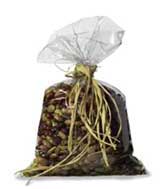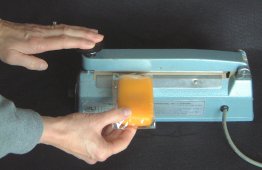Cellophane Bags Tutor | Cello Bags How To
 BOPP Cello Bags vs. Biodegradable Bags BOPP Cello Bags vs. Biodegradable Bags
Confused about the difference is between Cellophane Bags & Cello Bags & Biodegradable Bags? Let's try to demystify the differences by explaining a brief history of the "cello" bag.
The History of "Cello-Style" Bags
Cellophane is one of the oldest, clear packaging materials used to pack candy, nuts, baked goods & more. It was first marketed as a packaging material in the US in 1924, and was the predominant film until the 1960s. In the 1960s, a new breed of "cellophane-style" film, called Polypropylene (PP), gained popularity because of its low cost to manufacture, its abundance & its superior barrier properties. At this point, cello bags & cellophane bags came to reference both true cellophane (made of wood) & BOPP (bi-axially oriented polypropylene).
True cellophane is making a comeback today due to green awareness & eco-friendly markets. It is 100% biodegradable & is seen by many as a more earth-friendly packaging material than BOPP. Cellophane has an average water vapor rating and an excellent machinability & sealability.
How is True Cellophane Made?
Unlike man-made plastic polymers, which are largely derived from petroleum, cellulose is a natural polymer made from cellulose, a component of plants & trees. (CelloBags.com cellulose comes from specially managed, sustainable tree farms.) It is made from digested wood & cotton pulp that undergoes a series of chemical baths that remove impurities & break the long, fiberous chains in the raw materials. While cellulose is regenerated as a clear, shiny film with plasticizing chemicals added for flexibility, it is primarily composed of crystalline cellulose molecules. This means it can biodegrade with the assistance of micro-organisms in the soil, just as leaves and plants do.
What is BOPP Made of?
BOPP, Biaxially Oriented PolyPropylene,is a flexible material derived from melting and biaxially orienting(stretching on both axis) a polymer called polypropylene. This raw material is inert and unaffected by most chemical agents occurring in everyday life. It meets the requirements of the US Food and Drug Administration and other relevant authorities throughout the world. Polypropylene contains primarily carbon and hydrogen, and includes no heavy metals or other environmentally hazardous substances. The process of biaxially orienting polypropylene, stretching it in the machine direction and transverse direction, improves the films physical
properties, such as water vapor barrier, stiffness, dimensional stability, and optics.
Biodegradable & Compostable?
Tests have shown that, when buried or composted, un-coated cellulose film typically breaks down in an average of 28 to 60 days. Coated cellulose breakdown ranges from 80 to 120 days. In lake water, the average bio-degradation for un-coated is 10 days and 30 days for coated. Unlike true cellulose, BOPP film is not biodegradable, but rather, it is recyclable. BOPP remains inert when discarded, and it does not leach any toxins into the soil or water table. For a direct comparison on plastic vs. paper sustainability, click here to open our Sustainability page.
CelloBags.Com Products
While the majority of CelloBags.com products (& Prism Pak, Inc, our parent company) are plastic, we have expanded our "cello bag" offering to include a new category of Biodegradable Bags. Our Clear Cello Bags and Printed Cello Bags are made of BOPP material. As is industry practice, we co-mingle our phrases of "cello bags" and "cellophane bags" to reference the style of clear, shiny film, rather than the materials used. We will always call out Biodegradable on products that meet the criteria for biodegradability.
Properties Comparison of BOPP & Cellophane Bags
| Properties |
BOPP Cello Bags |
Cellophane Bags |
| Oxygen Barrier |
Excellent |
Excellent |
| Moisture Barrier |
Excellent |
Moderate |
| Aroma Barrier |
Excellent |
Excellent |
| Oil/Grease Resistance |
High |
High |
| FDA-Approved |
Yes |
Yes |
| Clarity |
High |
Moderate |
| Strength |
High |
High |
| Heat-Sealable |
Yes |
Yes |
| Compostable |
No |
Yes |
| Recyclable |
Yes |
No |
Below is an easy reference chart for current Cello Bag Items that we sell.
| Size |
Biodegradable Item # |
BOPP Item # |
| 3"w x 5.5"h flat 1mil |
BCF2 |
PN |
| 3.75"w x 6.5"h flat 1mil |
BCF4 |
CF |
| 4.75"w x 6.75"h flat 1mil |
BCF5 |
CF0 |
| 5.75"w x 7.75"h flat 1mil |
BCF6 |
CF1 |
| 6.75"w x 9"h flat 1mil |
BCF7 |
CF2 |
| 4"w x 2.75"d x 10.75"h 1mil |
BCS5 |
CS3 |
Cello Bags Sealing TechniquesAll of the bags can be heated sealed with a regular iron or a industrial Impulse Sealer shown in this picture. Or click here for a video demonstration of heat sealing. 
Keep your products tasting “fresh from the oven” delicious...
Breads Snack Cakes Soft Cookies Crispy Cookies Crackers
Our
cello bags are designed to keep baked products looking, smelling and
tasting fresher longer. Our specially formulated cello bags provide
exceptional barrier protection from odors, oxygen and moisture so your
product’s unique taste, texture and aroma are locked in.
The
best way to deliver “bake day” freshness to your customers is to ensure
that your product is equally protected from flavor loss and foreign
odor pickup. The barrier provided by our cello bags is the protection
your baked products need. Your customer will experience the same great
taste and texture each and every time they open a package.
If
you struggle with keeping crispy products tasting crunchy and soft
foods remaining moist and “melt in your mouth” delicious, then our
cello bags are your answer thanks to their superior barrier to moisture.
The
transparent high barrier packaging films for extended shelf life and
appeal promotion on the shelf, have been developed specifically for the
bakery market. These BOPP films include a differentially coated version
- a unique acrylic coating on one side and a very high barrier saran
coating on the other. The film enables food packers to achieve
extremely high levels of prolonged product protection. |
|
|